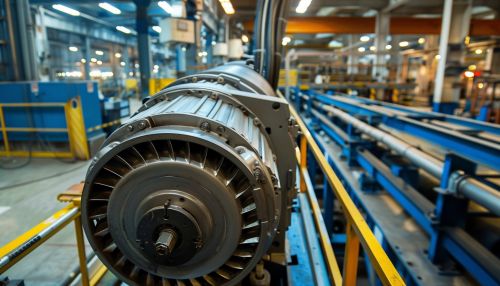Synchronous motor
Introduction
A synchronous motor is a type of electric motor that operates in synchronism with the frequency of the supply current. This type of motor is distinguished by its ability to operate at a constant speed, regardless of changes in load or voltage fluctuations. The speed of the motor is directly proportional to the frequency of the power source, making it a vital component in applications requiring precise and constant speed, such as in large industrial machinery and power generation systems.


Construction and Working Principle
The construction of a synchronous motor is similar to that of an alternating current (AC) motor, consisting of two main parts: the stator and the rotor. The stator is the stationary part of the motor that houses the armature windings. The rotor, on the other hand, is the rotating part of the motor.
The stator of a synchronous motor is similar to that of an induction motor, consisting of a cylindrical frame and a laminated core. The stator windings are placed in the slots of the laminated core, which are connected to a three-phase AC supply.
The rotor, however, is different from an induction motor. In a synchronous motor, the rotor can be of two types: salient pole and non-salient pole. The salient pole rotor has projecting poles mounted on a large diameter. These poles are excited by direct current (DC) to create a magnetic field. The non-salient pole rotor, also known as a cylindrical rotor, has a smooth cylindrical surface with slots to carry the field windings.
The working principle of a synchronous motor is based on the principle of magnetic locking, or synchronization. When the rotor is rotated at a certain speed, it locks into the rotating magnetic field produced by the stator, and the two rotate together at the same speed. This is why the motor is called a synchronous motor.
Types of Synchronous Motors
There are two main types of synchronous motors based on the method of excitation: non-excited and direct current excited.
Non-Excited Motors
Non-excited motors, also known as induction or asynchronous motors, use an external AC source to generate the magnetic field. These motors are simpler in design and construction, making them more cost-effective and easier to maintain. However, they are less efficient and have less torque than DC excited motors.
Direct Current Excited Motors
Direct current excited motors, also known as synchronous motors, use a separate DC source to generate the magnetic field. This type of motor is more efficient and has a higher torque than non-excited motors. However, they are more complex in design and construction, making them more expensive and harder to maintain.
Applications of Synchronous Motors
Synchronous motors are widely used in various industrial applications due to their constant speed operation and high efficiency. Some of the common applications of synchronous motors include:
- Power factor correction: Synchronous motors can operate at a leading power factor, making them useful for power factor correction in industrial plants. - Constant speed applications: Due to their ability to maintain a constant speed, synchronous motors are used in applications that require constant speed, such as large pumps, compressors, and fans. - High precision applications: Synchronous motors are used in high precision applications such as in robotics, CNC machines, and other automated systems where precise speed control is required.
Advantages and Disadvantages of Synchronous Motors
Like any other type of motor, synchronous motors have their advantages and disadvantages.
Advantages
- Synchronous motors can operate at a constant speed, making them ideal for applications requiring precise speed control. - They are more efficient than induction motors. - They can operate at a leading power factor, which can be used for power factor correction in industrial plants.
Disadvantages
- Synchronous motors are more complex in design and construction, making them more expensive to manufacture and maintain. - They require a separate DC source for excitation, which adds to the complexity and cost. - Starting a synchronous motor can be more complex than starting an induction motor.
See Also
- Electric motor - Alternating current - Stator - Rotor
